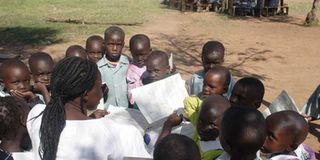Experts to back mother tongue for pupils, say good for rural schools

A nursery school teacher with her pupils. Pupils in primary schools will be taught in their respective mother-tongues from next year. FILE PHOTO | NATION MEDIA GROUP
What you need to know:
- The national steering committee, which comprises all education stakeholders, meets on Tuesday to approve the proposed curriculum before it is presented to the National Conference ahead of its piloting next year.
- According to the Basic education curriculum framework, the essence of mother tongue or indigenous language is to develop oral, reading readiness and writing readiness competencies in order to lay the foundation for language acquisition.
Pupils in primary schools will be taught in their respective mother tongues should a proposed new syllabus be endorsed at a national curriculum conference in Nairobi on Thursday.
Those to be taught in mother tongue will be in nursery school to Standard Three but it will be optional for upper school pupils.
The national steering committee, which comprises all education stakeholders, meets on Tuesday to approve the proposed curriculum before it is presented to the National Conference ahead of its piloting next year.
According to the Basic education curriculum framework, the essence of mother tongue or indigenous language is to develop oral, reading readiness and writing readiness competencies in order to lay the foundation for language acquisition.
In the proposed structure, pupils will take two years in pre-primary and three years in lower primary schools.
“The aim of language activities at pre-primary school level is to enable learners to express themselves fluently. The purpose of teaching language at this level is to also assist learners to improve listening ability, concentration, understanding and memory,” adds the framework that has been developed by Kenya institute of curriculum development (KICD).
The Unesco’s Global Education Monitoring Report (GEM Report) on Kenya also proposed that Kenyan children be taught in their mother tongue to enable them better understand what they are taught in school.
It says for early grade literacy and bilingual education to be successful, pupils need inclusive and relevant learning materials in a language they are familiar with.
“Textbooks, when available, are much less useful if learners have difficulty reading them, as was demonstrated in an experiment supplying textbooks written in English to Kenyan classrooms,” states the report that was released last year.
According to Angelina Kioko, a professor of English and Linguistics in Nairobi, the language of instruction in the country is English, and some learners in urban and some cosmopolitan settings speak and understand some English by the time they join school.
“But learners in the rural areas enter school with only their home language. For these learners, using mother tongue in early education leads to a better understanding of the curriculum content and to a more positive attitude towards school. There are a number of reasons for this,” observes Prof Kioko.
KICD notes that indigenous languages and dialects communicate valuable cultural values and norms that need to be transmitted across successive generations.
“Indigenous language activities will therefore be carried out in the language of the catchment area,” it adds and such activities will include listening, speaking, pre-reading and pre-writing.
This is expected to enhance the acquisition of language and relevant vocabulary as well as the acquisition of foundational skills and knowledge in speaking, reading and writing in indigenous languages.
Other languages to be taught in nursery schools include mathematics, environment, psychomotor and creative activities and religious and moral activity.
Digital literacy, financial literacy and pertinent and contemporary issues will be integrated across all learning areas.





